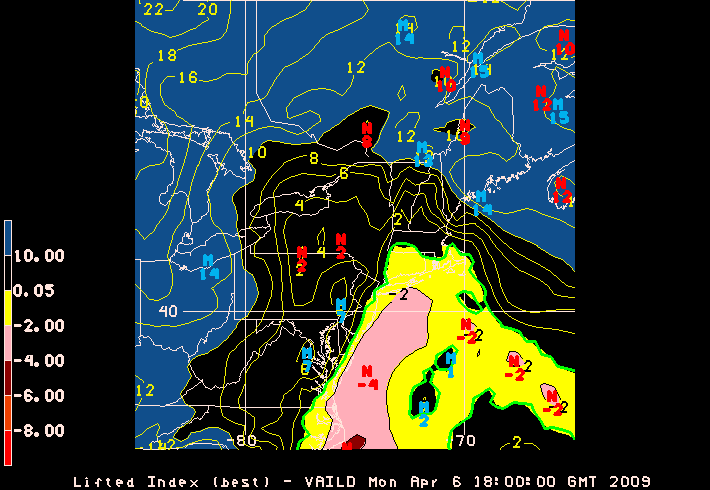Lifted index on:
[Wikipedia]
[Google]
[Amazon]
 The lifted index (LI) is the
The lifted index (LI) is the
Lifted Index
(
A look at LI
Convective indices
(NWS St. Louis)
AMS Glossary stability indices, including LI
* {{Meteorological variables Severe weather and convection Atmospheric thermodynamics
 The lifted index (LI) is the
The lifted index (LI) is the temperature
Temperature is a physical quantity that expresses quantitatively the perceptions of hotness and coldness. Temperature is measurement, measured with a thermometer.
Thermometers are calibrated in various Conversion of units of temperature, temp ...
difference between the environment Te(p) and an air parcel In fluid dynamics, within the framework of continuum mechanics, a fluid parcel is a very small amount of fluid, identifiable throughout its dynamic history while moving with the fluid flow. As it moves, the mass of a fluid parcel remains constant, ...
lifted adiabatically Tp(p) at a given pressure height in the troposphere
The troposphere is the first and lowest layer of the atmosphere of the Earth, and contains 75% of the total mass of the planetary atmosphere, 99% of the total mass of water vapour and aerosols, and is where most weather phenomena occur. From ...
(lowest layer where most weather occurs) of the atmosphere, usually 500 hPa HPA may refer to:
Organizations
* Harry Potter Alliance, a charity
* Halifax Port Authority, Canada
* Hamburg Port Authority, Germany
* Hawaii Preparatory Academy, a school in Hawaii, US
* Health Protection Agency, UK
* Heerespersonalamt, the Ger ...
( mb). The temperature is measured in Celsius. When the value is positive, the atmosphere (at the respective height) is stable and when the value is negative, the atmosphere is unstable
In numerous fields of study, the component of instability within a system is generally characterized by some of the outputs or internal states growing without bounds. Not all systems that are not stable are unstable; systems can also be mar ...
.
Determining LI
LI can be computed using computer algorithms but can also be determined graphically. To do this, generally, the parcel is lifted from the portion of theplanetary boundary layer
In meteorology, the planetary boundary layer (PBL), also known as the atmospheric boundary layer (ABL) or peplosphere, is the lowest part of the atmosphere and its behaviour is directly influenced by its contact with a planetary surface. On Ear ...
(PBL) that lies below the morning inversion
Inversion or inversions may refer to:
Arts
* , a French gay magazine (1924/1925)
* ''Inversion'' (artwork), a 2005 temporary sculpture in Houston, Texas
* Inversion (music), a term with various meanings in music theory and musical set theory
* ...
. The air here should be about 60 to 65% RH, which is then lifted along the dry adiabat (see also adiabatic process
In thermodynamics, an adiabatic process (Greek: ''adiábatos'', "impassable") is a type of thermodynamic process that occurs without transferring heat or mass between the thermodynamic system and its environment. Unlike an isothermal proces ...
) to the lifting condensation level (LCL), which is the intersection of that curve with the average mixing ratio in the boundary layer. Once the LCL is found, the parcel is lifted along the moist adiabat to 500 mb. It is then that one finds LI = Te(p) - Tp(p).
LI is generally scaled as follows:
* LI 6 or Greater, Very Stable Conditions
* LI Between 1 and 6 : Stable Conditions, Thunderstorms Not Likely
* LI Between 0 and -2 : Slightly Unstable, Thunderstorms Possible, With Lifting Mechanism (i.e., cold front, daytime heating, ...)
* LI Between -2 and -6 : Unstable, Thunderstorms Likely, Some Severe With Lifting Mechanism
* LI Less Than -6: Very Unstable, Severe Thunderstorms Likely With Lifting Mechanism
Significance to thunderstorms
The lifted index can be used inthunderstorm
A thunderstorm, also known as an electrical storm or a lightning storm, is a storm characterized by the presence of lightning and its acoustic effect on the Earth's atmosphere, known as thunder. Relatively weak thunderstorms are some ...
forecasting, however, convective available potential energy
In meteorology, convective available potential energy (commonly abbreviated as CAPE), is the integrated amount of work that the upward (positive) buoyancy force would perform on a given mass of air (called an air parcel) if it rose vertically thro ...
(CAPE) is considered by most as a superior measurement of instability and is preferred by many meteorologists for convection forecasting. However, LI is easier and faster to determine without using a computer, as determining CAPE requires integration from one level to another.
See also
*Atmospheric convection
Atmospheric convection is the result of a parcel-environment instability, or temperature difference layer in the atmosphere. Different lapse rates within dry and moist air masses lead to instability. Mixing of air during the day which expands the ...
* Atmospheric thermodynamics Atmospheric thermodynamics is the study of heat-to-work transformations (and their reverse) that take place in the earth's atmosphere and manifest as weather or climate. Atmospheric thermodynamics use the laws of classical thermodynamics, to descr ...
* Convective instability
In meteorology, convective instability or stability of an air mass refers to its ability to resist vertical motion. A ''stable'' atmosphere makes vertical movement difficult, and small vertical disturbances dampen out and disappear. In an ''uns ...
* Lapse rate
References
External links
Lifted Index
(
University of Illinois
The University of Illinois Urbana-Champaign (U of I, Illinois, University of Illinois, or UIUC) is a public land-grant research university in Illinois in the twin cities of Champaign and Urbana. It is the flagship institution of the Univer ...
)
A look at LI
Convective indices
(NWS St. Louis)
AMS Glossary stability indices, including LI
* {{Meteorological variables Severe weather and convection Atmospheric thermodynamics